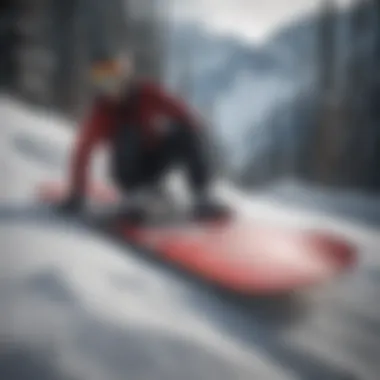Beginner's Guide to Buying Used Snowboards


Extreme Sport Overview
Snowboarding is a thrilling winter sport that blends elements of surfing, skateboarding, and skiing, providing a distinct adrenaline rush. In this section, we will delve into the essentials of snowboarding, specifically targeting beginner snowboarders who are interested in used equipment. Understanding the sport's foundation will help you navigate the complexities of selecting and using used beginner snowboards effectively.
Brief History of the Sport
Snowboarding originated in the United States during the late 1960s and early 1970s. Early enthusiasts modified existing equipment or created their own boards to navigate downhill snow-covered terrain. The sport gained significant popularity throughout the 1980s and was eventually included in the Winter Olympics in 1998. Today, snowboarding attracts millions of participants worldwide, offering a unique combination of skill, style, and competition.
Equipment Required
To start snowboarding, having the right equipment is crucial. Here’s a basic list of what you need:
- Snowboard: The most critical piece of equipment, which varies in size, shape, and flex according to skill level and riding style.
- Bindings: Connects your boots to the snowboard.
- Boots: Should offer comfort and support, specifically designed for snowboarding.
- Protective Gear: Helmets, wrist guards, knee pads, and padded shorts enhance safety while riding.
Safety Tips and Guidelines
Safety is paramount in snowboarding. Here are a few tips to keep in mind:
- Always wear a helmet for head protection.
- Learn the basic rules of the slopes to avoid collisions.
- Consider taking lessons from certified instructors for proper techniques.
- Stay within your skill level when selecting trails.
Relevant Statistics and Facts
Snowboarding continues to grow as a popular sport. In the 2021-2022 season, the National Ski Areas Association reported that approximately 7.5 million people participated in snowboarding in the United States alone. Furthermore, various studies reveal that effective training results in fewer injuries and a more enjoyable experience for beginners. Understanding these dynamics helps beginners appreciate the sport's culture and its commitment to safety.
"The key to enjoying snowboarding is knowledge—knowing your equipment, your limitations, and the environment you are riding in."
As we progress through this guide, every aspect of used beginner snowboards will be laid out in detail, from crucial selection criteria to maintenance tips. Emphasis will be placed on both performance and safety, aiming to equip you with the necessary skills to make informed decisions as you embark on your snowboarding journey.
Understanding Snowboarding Basics
Snowboarding is not just a sport; it’s an experience that combines skill, balance, and a deep connection to the snow. For beginners, understanding the fundamentals is essential for a safe and enjoyable journey on the slopes. This section will delve into the essence of snowboarding, covering its foundational aspects and why they matter, especially when considering used beginner snowboards.
Prologue to Snowboarding
Snowboarding involves a unique blend of balance and agility, requiring beginners to develop specific techniques to navigate different terrains. At its core, snowboarding is about riding on a board, allowing one to glide on snow-covered surfaces. Getting accustomed to the snowboard, understanding how it moves, and learning to balance can save a novice from many frustrations. As beginners embark on this venture, recognizing the nature of the sport can help shape their expectations, as well as their approach to learning.
Importance of Choosing the Right Gear
Selecting suitable equipment plays a crucial role in a successful snowboarding experience. Gear fits comfort and performance levels, which directly affects a rider's confidence. Beginners need to familiarize themselves with the various components of snowboarding gear. A used snowboard should not only be affordable but also appropriate for one’s height, weight, and skill level.
Choosing the right board can influence learning speed and enjoyment significantly; a properly matching snowboard can provide stability, while one that is too long or short can lead to difficulty in control. It is crucial to understand that gear designed for beginners facilitates a smoother entry into the sport. Beginners should pay attention to factors like board flex and shape, as these influence maneuverability.
Benefits of Used Snowboards
When considering the world of snowboarding, opting for used snowboards brings many advantages. These benefits appeal significantly to beginners, who are often cautious about making large investments in gear before fully committing to the sport. Choosing used snowboards can not only simplify entry into the sport but also align well with practical and environmentally conscious values.
Cost-Effectiveness
Cost is a primary consideration for many beginner snowboarders. New snowboards typically range in price considerably and can strain the budgets of novices. In contrast, used snowboards offer substantial savings. By purchasing a second-hand board, users can acquire quality equipment without the financial burden of a brand-new model.
When buying used, it's smart to look for models from reputable brands. Older models from companies such as Burton, Lib Tech, or K2 can still deliver excellent performance compared to their new counterparts. The depreciation of snowboard values means that a well-maintained used board can perform similarly to newer models, often at half the price.
To emphasize the cost benefits:
- Used snowboards can be up to 50% cheaper than new ones.
- This affordability allows beginners to invest more in lessons or safety gear, which enhances their overall experience.
In summary, seeking used equipment reduces initial expenditure. It also allows for exploration of different styles and sizes without a large financial commitment.
Environmental Considerations
Acquiring used snowboards contributes positively to environmental sustainability. The production of sporting equipment often involves significant resource consumption, including the extraction of materials and energy used in manufacturing. By purchasing used gear, snowboarders can minimize their environmental footprint.
The snowboarding community is increasingly recognizing its role in environmental preservation. When a snowboard is reused rather than discarded, it promotes a cycle of sustainability. Factors to consider include:


- Recycling Gear: Used equipment can come back to life, reducing waste in landfills.
- Sustainable Choices: Opting for second-hand gear supports a less resource-intensive option than new production.
"By choosing to buy used gear, every snowboarder contributes to a more sustainable future for the sport and the planet."
In summary, using previously owned snowboards aligns with a commitment to sustainability. It represents a mindful choice that benefits both the individual rider and the larger community by reducing environmental impact. Thus, selecting used snowboards is an economical and responsible choice, particularly relevant to beginners who are just beginning their journey in the sport.
Evaluating a Used Snowboard
Evaluating a used snowboard is crucial for making an informed purchase. A well-chosen snowboard can enhance your learning experience and provide safety on the slopes. On the contrary, a poor selection can lead to frustration and potential injuries. Understanding what to look for in a used snowboard helps ensure that you acquire gear that aligns with your skill level and riding style.
Physical Inspection Checklist
Checking for Damage
When checking for damage on a used snowboard, visual assessment is key. Look for cracks, deep scratches, or dents in the board. These flaws can seriously affect performance. A damaged snowboard may not hold an edge properly, which can compromise safety. It is often beneficial to ask the seller about the board's history. Has it been repaired before? Knowing this can help you decide whether to proceed with the purchase.
The key characteristic of checking for damage is vigilance. Sellers might not always disclose issues. A keen eye can save you from unexpected costs later on.
Assessing Base and Edges
Assessing the base and edges of the snowboard is another vital part of evaluation. The base should be well-maintained, with smooth surfaces free of gouges. Damaged bases can lead to poor glide and increased drag, impacting your overall riding experience. Edges are equally important; sharp and intact edges help with turns and stopping.
The unique feature of this inspection lies in its effect on control and balance. A board with compromised edges can be difficult to maneuver, which is particularly important for beginners. Ensure that edges are not rusted and show no signs of significant wear.
Evaluating Gear Quality
Evaluating the quality of snowboard gear plays an integral role in determining performance and durability. It consists of analyzing material types and understanding construction techniques. A solid understanding of these can help you make educated decisions.
Material Types
Material types used in snowboard production directly influence weight, flexibility, and responsiveness. Common materials include fiberglass, carbon fiber, and wood. Each type has its own benefits. For example, fiberglass provides a good balance of strength and weight. Carbon fiber is lighter but more costly, suitable for advanced riders.
The key characteristic here is understanding how materials will affect your riding experience. A beginner should typically opt for a board made from more forgiving materials to facilitate easier learning.
Construction Techniques
Construction techniques greatly determine the longevity and performance of the snowboard. A common method is sandwich construction, layering materials for strength and durability. Another approach is the full wood core design, which lends stability underfoot. Knowing these techniques allows you to understand the quality and expected performance of the snowboard.
The advantage of recognizing construction techniques is that it informs you about potential long-term value. While initially more expensive, a higher-quality construction can save you money in the long run by reducing the need for replacements.
Sizing Considerations for Beginner Snowboards
Selecting the correct size of snowboard is critical for any beginner. Appropriate sizing influences the performance and experience on the slopes. A snowboard that is too long or too short can hinder a beginner’s ability to learn and improve.
When assessing sizing, several factors come into play. The rider’s height, weight, and personal preferences shape these choices. Moreover, understanding how snowboards are measured can make the selection process smoother. Choosing the right snowboard size sets the foundation for a successful journey into snowboarding.
Understanding Snowboard Sizes
Snowboard sizes are generally categorized by length, which is typically measured in centimeters. Beginners often see boards that range from about 140 cm to 160 cm as their starting point. However, other aspects also play an important role. Each snowboard brand has a specific size chart, which provides guidance based on rider weight and height.
- Length: The most apparent measurement. The length of the snowboard affects stability at speed and turning radius.
- Width: This measures how wide the board is. A wider board may be necessary for those with larger feet to prevent toe or heel drag.
- Shape: Snowboards come in various shapes, and this can affect riding style as well. Understanding directional versus twin shapes can inform your decision.
Choosing the Right Size for Your Height and Weight
When selecting the right snowboard size, it's vital to consider both height and weight. This ensures maximal control and comfort. One common method is to hold the board vertically next to you. Ideally, the top of the board should align with somewhere between your chin and nose.
- Weight Considerations: Boards come with weight recommendations. A heavier rider typically needs a longer or stiffer board, while a lighter rider may benefit from a shorter and softer board.
- Height Guidelines: As height increases, so does the need for a longer board. A tall rider will find it hard to maneuver a short board effectively.
- Personal Preference: Riders may prefer a longer board for stability at speed, or a shorter board for easier turning. This choice can be influenced by the type of riding anticipated, such as freestyle or all-mountain.
Choosing the right snowboard size might seem intimidating, but focus on these basic criteria to make a suitable decision. Investing time in understanding your needs will help prevent future frustrations on the slopes. Remember, with the proper board, the journey into snowboarding becomes much more enjoyable.
Common Brands for Beginner Snowboards
When considering used beginner snowboards, understanding the common brands in the market is essential. Brands often come with reputations built over time. They can offer experience-backed products that cater to the requirements of novice riders. Identifying the well-established brands can help beginners make informed choices, especially when venturing into the used market.
Some brands are inherently more focused on durability and usability for starters. These qualities can influence a beginner’s confidence and comfort on the slopes.


Popular Brands in the Used Market
In the world of used snowboards, certain brands stand out due to their reputation and reliability. Some of the most notable ones include Burton, K2, Ride, and Salomon. Each brand has its strengths that often appeal to beginners:
- Burton: This is one of the most recognized names in snowboarding. They provide boards that are versatile, making them suitable for various conditions.
- K2: Known for their innovative designs, K2 offers boards that are user-friendly for beginners. They typically emphasize stability and ease of use.
- Ride: They focus on creating dynamic boards that can assist new snowboarders in improving their skills without sacrificing safety.
- Salomon: This brand is appreciated for its lightweight boards, making it easier for beginners to maneuver on the snow.
When purchasing a used snowboard from these brands, it's important to check for specific models designed for beginners. Many of these brands have various product lines that cater to different skill levels, including novice riders.
Identifying Quality Over Brand Recognition
While brand recognition is a useful guide, quality should be the primary factor when selecting a used snowboard. Beginners might feel drawn to names they recognize, but it is essential to evaluate the actual condition of the board and its suitability.
Factors to look out for include:
- Construction: Look at the materials used. Some brands may have lower-end options that are less durable. Materials like fiberglass and wood cores should be prioritized for longevity.
- Warranty and Support: Established brands often offer warranties or customer support even on used models. This can reassure beginners about their purchase.
- Reviews and Feedback: Searching for reviews specific to models can provide insight into performance and durability. Online forums like Reddit can be helpful for personal testimonies.
Unlike what some may think, some lesser-known brands also offer quality products. Thus, many times, a snowboard's quality can be found outside the spotlight of major names.
Evaluating boards based on their condition and specifications ensures that beginners get the best value for their investment and an overall better snowboarding experience.
Where to Buy Used Snowboards
Finding the right place to purchase used snowboards is crucial for beginners. The decision impacts not only the cost but also the quality and safety of the gear. Used snowboards can be found in various locations, but each comes with its own considerations. Understanding these avenues can enhance the buying experience and ensure a satisfying selection process.
Local Shops and Marketplaces
Local shops and marketplaces can be valuable resources for acquiring used snowboards. They often have physical stock which allows you to inspect the snowboard firsthand before making a purchase. This direct experience is an advantage because it helps you assess the snowboard's condition.
Benefits of Local Shops:
- In-Person Inspection: You can better evaluate the snowboard's quality and fit.
- Expert Advice: Staff in these shops usually have extensive knowledge and can guide you based on your skill level and preferences.
- Supporting Local Business: By purchasing from local shops, you contribute to the community.
Local marketplaces may include flea markets, garage sales, or consignment shops. While prices may vary, the chances of stumbling upon a good deal on a snowboard are higher. However, be cautious and thorough in your inspection when buying from these sources to ensure you're getting a reliable piece of gear.
Online Platforms for Used Gear
The digital age has opened up numerous avenues to buy used snowboards online. Platforms like eBay, Craigslist, Facebook Marketplace, and specialized sports gear websites cater to used gear enthusiasts.
Key Points about Online Buying:
- Broader Selection: Online platforms offer a wider variety of brands and models than local shops often can.
- Comparison Shopping: You can easily compare prices, quality, and seller ratings to ensure that you're making an informed decision.
- Ease of Access: Shopping from home is more convenient and can save time.
When using online platforms, consider the following:
- Seller Ratings: Check their ratings and reviews to avoid purchasing from unreliable sellers.
- Clear Descriptions: Pay attention to the details provided about the snowboard's condition, size, and specifications.
- Shipping Costs: Factor in any shipping fees, as these can add significantly to your total cost.
Engaging with local shops and online platforms allows beginners to make well-informed purchases.
"Where you buy your snowboard is just as important as which snowboard you choose. Assess your options to find the best fit for both your budget and experience."
Taking the time to explore these avenues can lead to a fruitful investment in the right snowboard. Remember, each choice shapes your initiation into the snowboarding world.
Maintenance Tips for Your Used Snowboard
Maintaining a used snowboard is crucial for both performance and safety. With proper care, you can extend the life of the equipment while ensuring an enjoyable riding experience. This section covers essential elements of snowboard maintenance. Understanding these tips is especially important for beginners who may not be familiar with upkeep requirements.
Basic Care and Storage
The way you care for and store your snowboard significantly affects its longevity and performance. Proper maintenance begins with simple daily practices. First, always clean the board after each ride. Snow, mud, and dirt can accumulate, which may lead to damage over time. Use a soft cloth or sponge to wipe down the surface.
When it comes to storage, avoid keeping the snowboard in damp or humid locations. A cool, dry place is ideal. If you can, keep it upright in a snowboard bag. This will prevent unnecessary pressure and damage. Additionally, avoid leaving it in direct sunlight for long periods. UV rays can degrade materials and graphics, leading to excessive wear.
Regular checks for edge damage are also necessary. If you notice any significant burrs or cracks, take corrective measures immediately. Ignoring these can worsen the problem and impact riding performance.


"Routine maintenance of your snowboard can save you from expensive repairs and ensure a safer experience on the slopes."
Professional Tune-Ups
Even with diligent care, professional tune-ups are beneficial for maintaining your snowboard. A qualified technician can offer thorough inspections that go beyond regular care. They can assess the base and edges more accurately. This includes base grinding, which helps restore the board's smoothness and performance.
Waxing is another key aspect of professional maintenance. Regular waxing improves glide and protects the base from drying out. This process fills in microscopic pores, facilitating better snow interaction. Your technician can recommend an appropriate waxing schedule based on your riding frequency.
It’s also wise to have bindings checked for damage or wear. Faulty bindings can lead to serious accidents if not properly maintained. Some professionals will offer seasonal tune-ups, ensuring your board is ready for use each winter.
Safety Considerations
Safety is paramount when it comes to snowboarding, particularly for beginners using second-hand gear. Understanding the necessary safety measures can significantly affect the overall experience on the slopes. This section will explore critical safety aspects, focusing on checking bindings, the right fit, and much more.
Checking Bindings and Boots
Bindings play a crucial role in ensuring that the rider stays securely attached to the snowboard. Therefore, it’s essential to inspect them thoroughly. Potential issues include signs of wear and tear, such as cracks or loose screws.
- Visual Inspection: Make sure to look for any visible damage. If there are scratches or fractures, it could indicate a need for replacement.
- Functionality Test: Make sure to engage and disengage the bindings several times. They should operate smoothly. Any difficulty could suggest that they need maintenance or even replacement.
- Compatibility with Boots: It is also important to check whether the bindings are compatible with your boots. Mismatch could lead to improper foot positioning, affecting balance and safety during rides.
Regular checks of bindings ensure that you are well-prepared before hitting the slopes. Ideally, make these checks a part of your routine before any snowboarding session.
Importance of Proper Fit
The fit of both the snowboard and the boots is another key factor in ensuring safety and comfort. An improper fit can lead to heightened risk of injury. When assessing fit, consider the following:
- Snowboard Size Relative to Rider: It's crucial to choose a snowboard size that corresponds to your height and weight. A board that is too long or too short can affect control and stability, leading to falls.
- Boot Size and Flex: Ensure that the boots fit snugly without being overly tight. Boots that are too loose can cause your foot to move inside, impacting your ability to steer. Conversely, excessively tight boots can restrict blood flow, leading to discomfort.
- Personal Adjustment: Once you obtain the right fit, you may need to make minor adjustments over time as comfort preferences change. Regularly revisiting the fit is a good practice.
A proper fit in snowboarding gear not only enhances performance but dramatically reduces the risk of injury.
Addressing these safety considerations should provide you with a secure and enjoyable snowboarding experience. Understanding the significance of gear checks and fit can make a substantial difference, particularly for beginners.
Common Mistakes to Avoid When Purchasing
When entering the world of snowboarding, particularly for beginners, the purchasing process can be overwhelming. Missteps in this phase can lead to wasted money and an unsatisfactory experience on the slopes. Understanding common mistakes is essential to making informed decisions, ultimately enhancing your snowboarding journey.
Ignoring Experience Level
It's tempting to buy the most advanced snowboard you see, but ignoring your own experience level is a common mistake many beginners make. Different boards cater to various styles and skills. If a novice chooses a board designed for advanced techniques, they might find it difficult to control. This can result not only in frustration but also in potential injury.
Consider your comfort on snow. A snowboard suitable for beginners typically has a softer flex and a design that makes turning and stopping easier. This is beneficial for learning basic skills such as balance and coordination. It’s crucial to recognize that each rider is unique, and what works for one person might not be suitable for another. Thus, engaging with local shops or experienced riders can provide valuable insights tailored to your personal skill set.
Neglecting Quality Checks
Another frequent downfall is neglecting quality checks during the purchase. Used gear can vary significantly in condition, and purchasing a snowboard without proper inspection can lead to serious consequences. Signs of wear, such as deep scratches on the base or damaged edges, indicate that the board may not perform well or might even be unsafe.
When evaluating a used snowboard, consider several quality aspects:
- Base Condition: Look for gouges, cracks, or repairs. A well-maintained base ensures a smoother ride.
- Edges: Check for rust or burrs. Sharp edges are essential for grip and control.
- Bindings: Inspect the bindings for functionality and wear. They should be properly adjustable to ensure safety.
- Overall Structure: Avoid boards that show signs of serious damage. A structurally sound board will provide a better experience.
Purchasing used beginner snowboards does not mean sacrificing quality if proper checks are made. This step can prevent potential mishaps and costly replacements.
"Taking the time to check quality can save you from headaches and injury. It's worth the effort."
The End
In this article, we have explored various facets of using used beginner snowboards. It is essential to reinforce the importance of understanding the process of selecting, maintaining, and enjoying these snowboards. The insights provided here cater to the specific needs and concerns of novice snowboarders.
Final Thoughts on Used Beginner Snowboards
Used snowboards offer a practical solution for those just starting their snowboarding journey. These boards can provide a favorable balance between cost and performance. It is critical to thoroughly evaluate the equipment for quality and suitability. Having the right gear reduces the risk of injury and ensures a more enjoyable experience.
When making a purchase, keep in mind that the brand’s reputation should not overshadow the actual condition and functionality of the snowboard. It is also useful to read reviews from other beginners who have walked this path. Each individual’s preferences vary, which means that an informed choice can significantly enhance overall satisfaction on the slopes.
"Understanding the balance between performance and cost is vital for novice snowboarders looking to take their first rides on the mountain."
Encouragement for New Adventurers
For those new to snowboarding, it is crucial to embrace the learning curve. Each descent will provide valuable insights and skill improvements. Snowboarding is a challenging sport, yet the reward is worth the effort. The social aspect of snowboarding shouldn't be overlooked; joining a community can enhance the experience, sharing tips and building lasting friendships.
As you venture into this exhilarating sport, remember that every snowy slope offers a new opportunity for growth. Equip yourself with knowledge from this guide and others like it. The mountains are waiting, and your adventure is just beginning.



